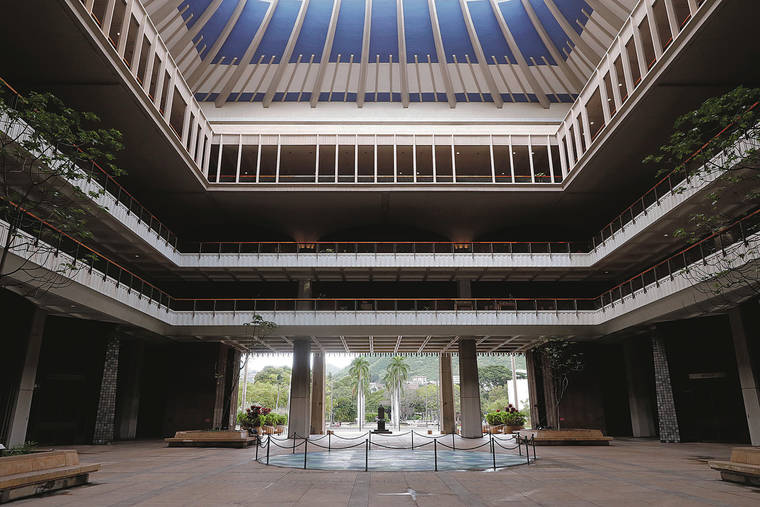Editorial: Fiscal and public-health planning, with transparency, top the to-do list

JAMM AQUINO / JAQUINO@STARADVERTISER.COM
The Hawaii State Capitol rotunda is seen on March 19 in Honolulu. When legislators get down to business on Monday — socially distant business, that is — they will have to weigh where the cuts will come from, and how to preserve enough of the essential services the public will need as Hawaii climbs out of an economic chasm.
To be sure, this will not be a Legislature reopening filled with ceremony, flowers and song. When lawmakers regroup formally for the first time since the coronavirus pandemic Opens in a new tab shut everything down, there won’t be anyone in a celebratory mood.
Instead, they will have to cope with an anticipated budgetary hole that, by some estimates, exceeds $1 billion. This is the loss in tax revenue from the lockdown on most businesses, as the community battled infections with COVID-19, with the tourism industry’s virtual closure adding the most red ink.
When legislators get down to business on Monday — socially distant business, that is — they will have to weigh where the cuts will come from, and how to preserve enough of the essential services the public will need as Hawaii climbs out of an economic chasm.
And they will need to do it with the sunshine pouring in, full force. The suspension of the state’s open-meetings and open-records laws during the crisis has left people doubting the power of their own voice in government.
This point will be an important element in the truncated legislative proceedings that are about to begin. Addressing some of the economic damage can be delayed for a time, with officials hoping there may be further budgetary rescue packages coming from the federal government set aside for state and local governments.
Based on their recent public statements, legislators seem leery of massive public-worker furloughs or pay cuts, and point to a fat rainy-day fund of some $400 million that can be tapped. There are also vacant positions across state government that can go dark.
Don't miss out on what's happening!
Stay in touch with breaking news, as it happens, conveniently in your email inbox. It's FREE!
At a minimum, lawmakers can and should commit to shielding pay and positions for classroom teachers, the health-care sector and first-responders, all of whom will continue to shoulder a heavy burden in the months ahead.
But there are many tough fiscal decisions that they will have to make, not all of them cans to be kicked down the road, whether or not this is an election year. There are various approaches that deserve full discussion, including how federal aid should be spent.
To their credit, the legislative briefings on COVID-19 in the interim have been helpful at prodding for more information from the administration of Gov. David Ige.
Lawmakers have applied needed pressure on the administration to get some of its sidelined workforce redeployed to urgent tasks such as the clearing of backlogged claims for unemployment insurance and funding from the new Pandemic Unemployment Assistance program.
Inexplicably — or perhaps too predictably — the governor balked at pressing his workforce to jump into the fray, even though his emergency proclamations gave him the power to do so. Political will is what has been lacking, not political power.
More grilling of the governor is to be expected in the days ahead. The Ige administration has succeeded in driving down coronavirus cases by restricting tourism, which was a necessary step. It has put Hawaii in the enviable position of having a handle on the public health challenge at this point.
But it has come at a heavy toll, with unemployment topping 37%, or more than 1 in 3 workers now jobless; many are still awaiting unemployment checks. The administration must be more forthcoming with the particulars of its recovery blueprint.
Legislators and county officials alike were stunned last week when Ige suddenly announced the opening of more retail operations. Businesses needed more preparation time than they were given in order to ramp up with any hope of success. And success will hinge in large part on the consumers’ confidence that they can engage safely in commercial activity, even with social-distancing and sanitation provisions in place.
It would help immensely to know that there is a firm plan for increasing testing capacity and, most critically, for increasing the workforce needed to conduct adequate contact tracing once the numbers of new infections tick up.
Even if that capacity is adequate now, the public needs to know that tracers are at the ready and being trained so that they can be deployed when needed. Mayor Kirk Caldwell on Friday vented his own frustration with the administration over its testing and tracing strategy.
He makes a rational argument, but it’s now the Legislature that is in the best position to get some answers.
Lawmakers also have to look downstream and anticipate what pandemic fallout lies ahead. Safety- net programs must be bolstered for what’s sure to be an onslaught of new demand — the crowds at recent grocery giveaways made that clear. Protections for renters who need time to finance their debts should be discussed. Emergency shelter for the newly homeless will become a critical concern.
Taxpayers certainly realize that curbs will be placed on government functions at some point, even if addressing some of the economic damage can be delayed. But they need to have responsive and efficient services for their money, given how much pain they’ve already endured, and how much lighter their wallets feel now.




